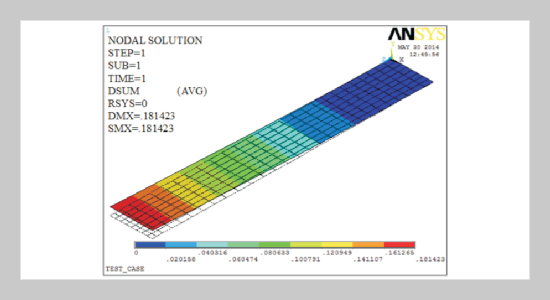REFERENCES
- [1] Mac Gaunaa, Peter B., Anderson, Christian D. and Bak, Thomas Buhl, “Adaptive Trailing Edge Flap Recent Development within Smart Blades,” Proc. of 2010 Wind Turbine Blade Workshop, Albuquerque, NM, Aeroelastic Design Program Wind Energy Division, Risø DTU (2010).
- [2] Aagaard Madsen, H., Andersen, P. B., Løgstrup Andersen, T., Bak, C., Buhl, T. and Li, N., “The Potentials of the Controllable Rubber Trailing Edge Flap (CRTEF),” EWEC 2010 Proceedings online, European Wind Energy Association (EWEA) (2010). doi: 10.1016/S0015-1882(01)80293-7
- [3] Andersen, P. B., Henriksen, L., Gaunaa, M., Bak, C. and Buhl, T., “Deformable Trailing Edge Flaps for Modern Megawatt Wind Turbine Controllers Using StrainGauge Sensors,” Wind Energy,Vol.13, No. 2�3, pp. 193�206 (2010). doi: 10.1002/we.371
- [4] Haans, W., Sant, T., van Kuik, G. and van Bussel, G., “HAWT Near-wake Aerodynamics, Part I: Axial Flow Conditions,” Wind Energy, Vol. 11, No. 3, pp. 245� 264 (2008). doi: 10.1002/we.262
- [5] Bontekoning, M. P. C., Perez-Moreno, S., Ummels, B. C. and Zaaijer, M. B., “Analysis of the Reduced Wake Effect for Available Wind Power Calculation During Curtailment,”Proc. of IOPWake Conf. Series: Journal of Physics: Conf. Series 854, 11 pages (2017). doi: 10.1088/1742-6596/854/1/012004
- [6] Hodges, D. H., Crespo da Silva, M. R. M. and Peters, D. A., “Nonlinear Effects in the Static and Dynamic Behavior of Beams and Rotor Blades,” Vertica, Vol. 12, pp. 243�256 (1988).
- [7] Peters, D. A. and Johnson, M. J., “Finite-state Airloads for Deformable Airfoils on Fixed and Rotating Wings,” Aeroelasticity and Fluid-Structure Interaction Problems, ASME, AD-Vol. 44, pp. 1�28 (1994).
- [8] Crespo de Silva, M. R. M., “A Comprehensive Analysis of the Dynamics of a Helicopter Rotor Blade,” International Journal of Solids and Structures, Vol. 35, No. 7�8, pp. 619�635 (1998). doi: 10.1016/S00207683(97)00065-6
- [9] Pai,P.F.and Palazotto,A.N., “Large-deformation Analysis of Flexible Beams,” International Journal of Solids and Structures, Vol. 33, No. 9, pp. 1335�1353 (1996). doi: 10.1016/0020-7683(95)00090-9
- [10] Pai, P. F., Anderson, T. J. and Weather, E. A., “Large deformation Tests and Total-lagrangian Finite-element Analysis of Flexible Beams,” International Journal of Solids and Structures, Vol. 37, No. 21, pp. 2951�2980 (2000). doi: 10.1016/S0020-7683(99)00115-8
- [11] Fulton, M. V. and Ormiston, R. A., “Hover Testing of a Small-scale Rotor with On-blade Elevons,” Journal of the American Helicopter Society, Vol. 46, No. 2, pp. 96�106 (2001). doi: 10.4050/JAHS.46.96
- [12] Nikhil, A. K. and Chopra, I., “Open-loop Hover Testing of a Smart Rotor Model,” AIAA Journal, Vol. 40, No. 8, pp. 1495�1502 (2002). doi: 10.2514/2.1834
- [13] Kurdila, A. J., Li, J., Strganac, T. and Webb, G., “Nonlinear Control Methodologies for Hysteresis in PZT Actuated On-blade Elevons,” Journal of Aerospace Engineering, Vol. 16, No. 4, pp. 167�176 (2003). doi: 10.1061/(ASCE)0893-1321(2003)16:4(167)
- [14] Chou, K.C., Development of Blade & Tower Structure and Monitoring System for the 1KW Wind Turbine, Master Thesis, Department of Aeronautics & Astronautics, National Cheng Kung University (2011).
- [15] Bergami, L., “Adaptive Trailing Edge Flaps for Active Load Reduction,” Wind Energy Division, Ris DTUNational Laboratory for Sustainable Energy, Proc. of the 7th Ph.D. Seminar on Wind Energy in Europe, Delft, Netherlands (2011).
- [16] Jonkman, J., Butterfield, S., Musial, W. and Scott, G., “Definition of a 5-MW Reference Wind Turbine for Offshore System Development,” National Renewable Energy Laboratory Technical Report, NREL/TP-500-38060 (2009).
- [17] M., Siddiqui, M. S., Rasheed, A., Tabib, M. and Kvamsdal, T., “Numerical Analysis of NREL 5MW Wind Turbine: a Study towards a Better Understanding of Wake Characteristic and Torque Generation Mechanism,” Proc. of the Science of Making Torque from Wind (TORQUE 2016), Journal of Physics: Conf. Series 753, 10 pages (2016). doi: 10.1088/ 1742-6596/753/3/032059
- [18] Wang, Y. R. and Chang, Y. S., “The Effects of an Onblade Trailing Edge Flap on Rotor Dynamics in Hover,” Journal of Aeronautics, Astronautics and Aviation, Series A, Vol. 43, No. 4, pp. 241�250 (2011).
- [19] Peters, D. A. and He, C. J., “Comparison of Measured Induced Velocities with Results from a Closed Form Finite State Wake Model in Forward Flight,” Proc. of the45th Annual National Forum of the American Helicopter Society, Boston, Massachusetts, May 22�24 (1989). doi: 10.4050/JAHS.36.59
- [20] Wang, Y.-R. and Peters, D. A., “The Lifting Rotor Inflow Mode Shapes and Blade Flapping Vibration System Eigen-analysis,” Computer Methods in Applied Mechanics and Engineering, Vol. 134, No. 1�2, pp. 91–105 (1996). doi: 10.1016/0045-7825(96)01027-4
- [21] Johnson, W., Helicopter Theory, Princeton University Press, Princeton (1980). [22] Lee, J. W., Lee, J. S., Han, J. H. and Shin, H. K., “Aeroelastic Analysis of Wind Turbine Blades Based on Modified Strip Theory,” Journal of Wind Engineering and Industrial Aerodynamics, Vol. 110, pp. 62�69 (2012). doi: 10.1016/j.jweia.2012.07.007









